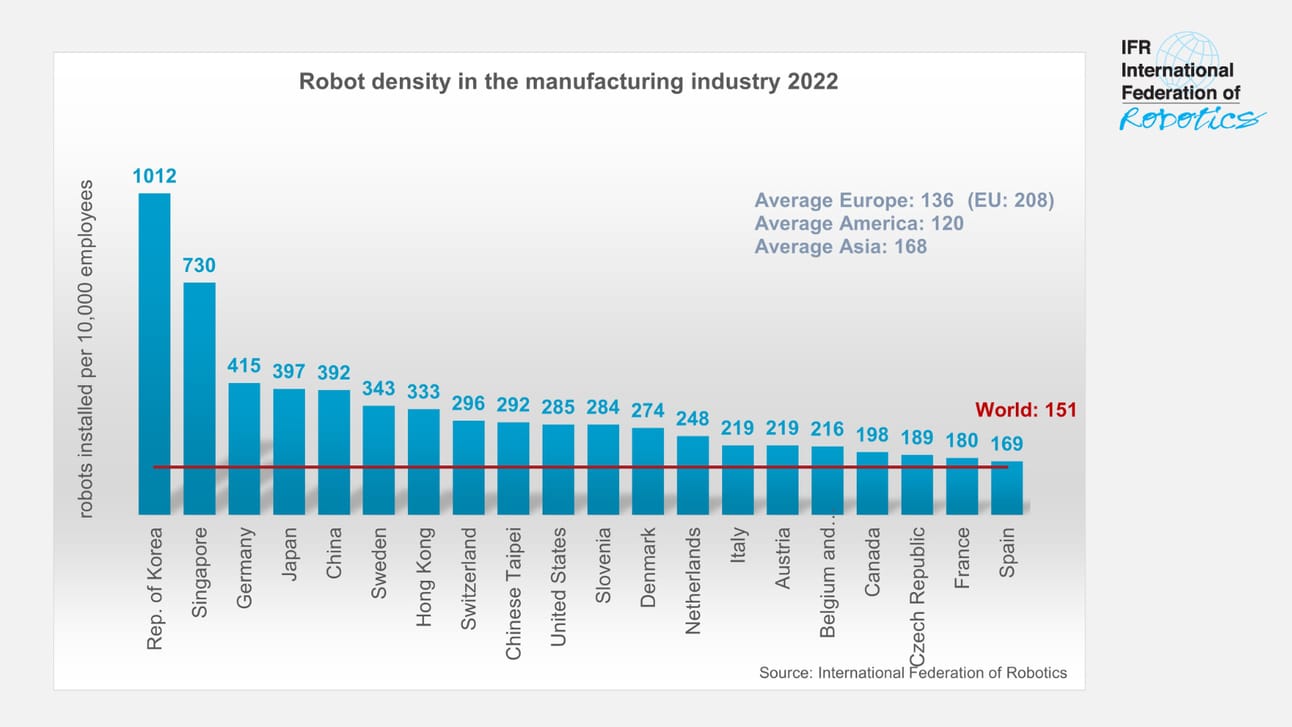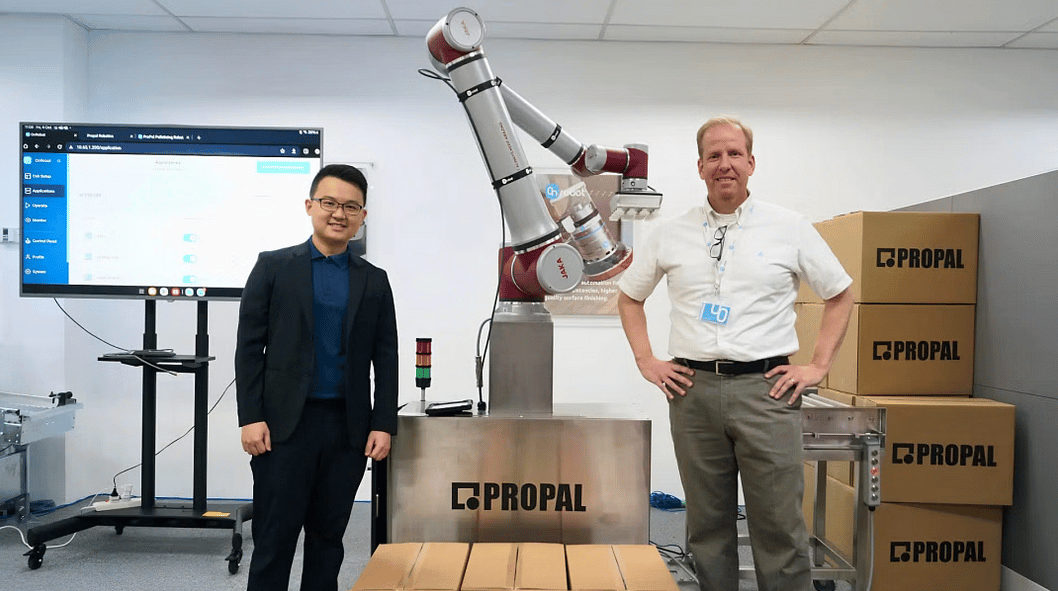- TheCobotReport
- Posts
- #03 TheCobotReport
#03 TheCobotReport
Record growth, emerging robotics hub & safer robots...

This week, we're diving into some exciting developments in the world of automation. From a record surge in global robot installations to Pittsburgh's rise as a collaborative robotics powerhouse, there's no shortage of innovation to cover.
In this week’s email…
Quick Hit: Robotics Surge: Record Growth and Key Opportunities.
Movers & Shakers:
Pittsburgh: The Next Cobot Powerhouse.
Affordable Automation for SMEs: OnRobot and ProPal Robotics Launch Collaborative Palletisers.
Graduate Corner: Anticipating Human Behavior for Safe Navigation and Efficient Collaborative Manipulation with Mobile Service Robots
Upcoming Events: Key conferences and workshops to keep on your radar in the robotics and AI fields.

In the news…
Chang Robotics unveils Robot Studio at Jacksonville University.
Collaborative Robotics hires a former Amazon AI leader, opens Seattle office after $100M round
Pittsburgh Steels Itself for Innovation With Launch of NVIDIA AI Tech Community
Antigua's Young Robotics Team Tackles Global Food Security at 2024 FIRST Global Challenge

QUICK HIT:
Robotics Surge: Record Growth and Key Opportunities

image courtesy of
The global robotics industry reached new milestones in 2023, with the highest-ever number of robots employed in factories worldwide. This growth was largely driven by significant installations in Asia and an increased focus on automation across various industries, including automotive and manufacturing. Despite minor declines in some regions, the overall trend points towards a stable and expanding robotics market, with expectations for continued growth in the coming years.
Over 4.2 million robots were employed in factories worldwide in 2023, a 10% increase from 2022.
4,281,585 robots were operating globally, according to the World Robotics Report by the International Federation of Robotics.
Annual installations of robots exceeded 500,000 units for the third consecutive year.
Regional breakdown of new installations in 2023: 70% in Asia, 17% in Europe, 10% in the Americas.
541,302 robots were installed in 2023, the second highest in history, only 2% lower than the 2022 record of 552,946 units.
China installed 276,288 robots in 2023, accounting for 51% of global installations.
The share of Chinese manufacturers in the domestic market grew to 47% in 2023, up from an average of 28% over the past decade.
China’s operational stock of robots was just under 1.8 million units.
Japan installed 46,106 robots in 2023, down 9% from 2022, making it the second largest global market.
South Korea installed 31,444 robots in 2023, down 1% year on year, ranking as the fourth largest market.
India saw a 59% increase in robot installations to 8,510 units in 2023, with automotive industry demand up 139% to 3,551 units.
Europe saw a 9% increase in installations, reaching 92,393 units in 2023.
Germany: 28,355 units installed, up 7%.
Italy: 10,412 units installed, down 9%.
France: 6,386 units installed, down 13%.
The Americas installed 55,389 robots in 2023, just 1% below the 2022 record.
United States: 37,587 units installed, down 5%, accounting for 68% of the Americas' installations.
Canada: 4,311 units installed, up 37%.
Mexico: 5,832 units installed, down 3%.
Global robot installations are expected to level off at 541,000 units by 2024, with growth accelerating in 2025 and continuing through 2027.
Investors take note: Focus on China and India for investment opportunities. China installed 276,288 robots, accounting for 51% of global installations, while India saw a 59% rise, driven by automotive demand. Germany and Canada's growth also highlight promising sectors for automation investments.

MOVERS & SHAKERS:
1 . Pittsburgh: The Next Cobot Powerhouse

image courtesy of Pittsburgh Robotics Network
The Pittsburgh Robotics Network (PRN) is driving robotics innovation, particularly in collaborative robotics. PRN, along with the Robotics Factory by Innovation Works, has supported numerous startups in developing cobot related technologies, helping make Pittsburgh a leading robotics hub.
The Robotics Factory, launched in 2023 with funding from the $63 million Build Back Better Regional Challenge grant, supports local robotics startups with funding, mentorship, and networking. Since the start of its Accelerate Program, PRN has helped over 10 startups, providing up to $100,000 in investment and 6 months of structured programming.
Humotech: Develops wearable robotics for prosthetics and exoskeletons, enhancing human mobility and safety.
Journey Robotics: Focuses on aviation automation for handling passenger cargo, increasing efficiency and reducing manual workload.
Cell X Technologies: Creates automation solutions for regenerative medicine, improving precision and reducing manual labor in healthcare. It raised over $6 million in Seed Stage funding.
With over 125 robotics organizations and growing investment, Pittsburgh is emerging as a leading city for collaborative robotics innovation.
Investors Take Note: Pittsburgh's robotics ecosystem is rapidly expanding, offering promising investment opportunities. Startups like Humotech, Journey Robotics, and Cell X Technologies are at the forefront of innovation. Investors looking for growth in healthcare, automation, and collaborative technologies should consider this thriving sector.
2. Affordable Automation for SMEs: OnRobot and ProPal Robotics Launch Collaborative Palletisers

Image courtesy of techedt
OnRobot, in collaboration with ProPal Robotics, has launched an off-the-shelf collaborative palletiser for SMEs in Singapore, aimed at simplifying automation. Powered by OnRobot's D:PLOY platform, the ProPal20 and ProPal20L palletisers offer same-day installation, no programming, and re-deployment in minutes.
Singapore's SME market, comprising 99% of all businesses, faces challenges: 79% report difficulty finding skilled talent in 2024, and 86% struggle to compete with multinational corporations. With 1 in 4 citizens projected to be 65+ by 2030, the demand for automation is rising to counter workforce shortages.
Traditionally, palletising is labor-intensive due to high-mix production lines. ProPal20 automates stacking goods up to 12 kg at 8 boxes per minute, integrating the JAKA Zu20 cobot with OnRobot's VGP20 gripper. D:PLOY software allows operators to easily switch between tasks, reducing setup times to minutes.
SMEs can deploy automation in hours, saving up to 90% on deployment time compared to conventional systems. The ProPal20 is priced at SGD 73,000, while the ProPal20L, featuring extended stacking capabilities (up to 2400 mm), is available at SGD 89,000, both with a 12-month warranty, installation, and training.
Investors take note: With rising automation demand due to labor shortages and an aging population, OnRobot and ProPal Robotics are well-positioned for market growth. The affordable pricing and ease of deployment make the ProPal series an attractive opportunity for investors seeking scalable automation solutions in the SME sector.

GRADUATE CORNER:
Anticipating Human Behavior for Safe Navigation and Efficient Collaborative Manipulation with Mobile Service Robots
Simon Bultmann, Raphael Memmesheimer, Jan Nogga, Julian Hau, and Sven Behnke
at Autonomous Intelligent Systems group, University of Bonn, Germany
arXiv:2410.05015 Submitted on 7 Oct 2024

Robots with anticipatory behavior are safer and more effective collaborators.
Smart edge sensors help robots predict human movements.
Enhances navigation safety and supports collaborative tasks, like furniture-moving.
This research explores how integrating anticipatory behavior into robots can make them safer and more effective partners for humans.
The study uses a smart edge sensor network to help robots anticipate human movements, enhancing both navigation safety and collaborative tasks. By predicting and responding to human actions, robots can better navigate complex environments and assist in collaborative tasks without causing disruptions or safety concerns. For example, the robot can predict human trajectories for smoother navigation or anticipate a human's intent during a furniture-moving task.
These capabilities lead to a more seamless and harmonious interaction between robots and humans, where the robots' behavior feels more predictable and supportive. The experiments demonstrate that these anticipatory capabilities make the robot a more intuitive and efficient collaborator, contributing to safer human-robot environments. This marks a significant step towards more natural and fluid interaction between humans and robots in shared spaces.
Investors take note: The integration of anticipatory behavior into robotics opens up exciting investment opportunities in the field of human-robot interaction, particularly in sectors like healthcare, logistics, and smart home environments, where safety and collaboration are critical.
Upcoming Events:
FABTECH : Oct-15-2024 | Orlando, United States of America
RoboBusiness : Oct-16-2024 | Santa Clara, United States of America
ROSCon : Oct-21-Oct 2024 | Odense, Denmark
ROSConEdu China : Nov-02-2024 | Shenzhen, China
Reply